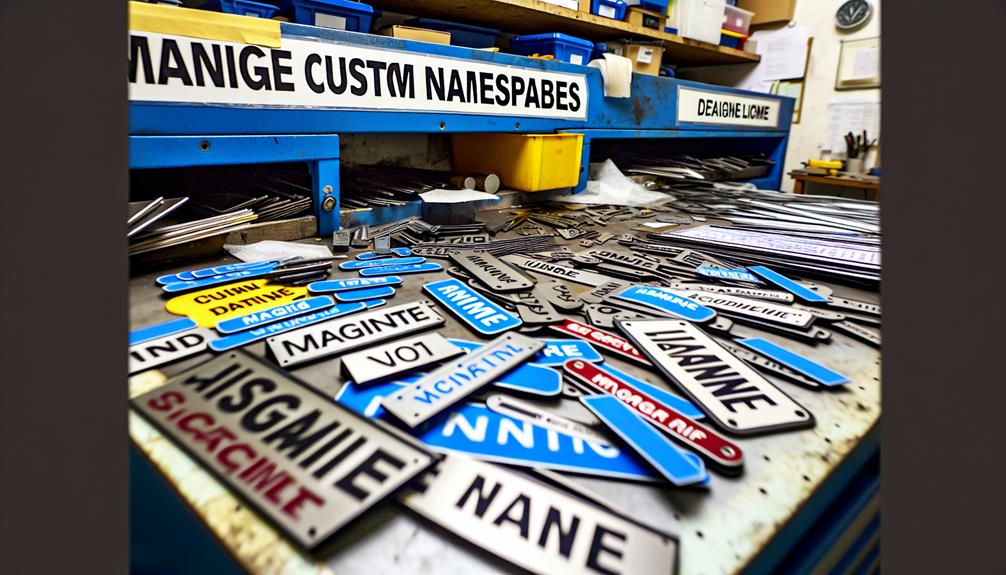Custom equipment nameplates play an integral role in various industries, embodying a synthesis of functionality and branding. These nameplates, tailored to specific requirements, not only facilitate the easy identification and tracking of equipment but also reinforce brand identity through customized designs incorporating logos, color schemes, and durable materials. The choice of material—be it metal or polymer—along with design considerations, significantly impacts both the longevity and visibility of these nameplates in challenging environments. As businesses continue to recognize the importance of these elements, one might wonder how the evolution of material technology could further enhance the effectiveness of custom equipment nameplates in the near future.

Custom nameplates are specifically designed labels that identify and provide information about the equipment to which they are attached. These labels are not only functional but also serve as a critical tool for custom branding and personalization.
Through customization, businesses can incorporate their logos, color schemes, and specific typography, aligning the physical appearance of their equipment with their corporate identity. This degree of personalization enhances the recognition of their brand while maintaining a high level of professionalism.
The process of creating custom nameplates involves precise identification and customization techniques. Each nameplate is tailored to meet specific industrial requirements, which can include varying sizes, materials, and adhesion properties depending on the environmental conditions and the surfaces to which they will be applied.
The customization options are extensive, allowing for the inclusion of other vital information such as serial numbers, barcodes, and QR codes, which further enhance the functionality of the equipment by facilitating tracking and inventory management.

In various industries, custom nameplates play an essential role in ensuring equipment is clearly identified and efficiently managed. These markers are crucial for maintaining safety compliance and enhancing traceability, which are paramount in sectors such as manufacturing, aerospace, and healthcare. By using custom nameplates, companies assert control over their physical assets and ensure that every piece of equipment can be quickly and accurately identified.
Custom nameplates also serve as a powerful tool for branding. They not only reinforce the identity of the company but also elevate the perceived quality of the equipment. This is particularly beneficial in industries where brand recognition contributes significantly to market positioning and customer trust.
Here is a brief overview of the importance of custom equipment nameplates in various applications:
| Application | Benefit |
|---|---|
| Industrial | Facilitates operational efficiency and asset management |
| Safety Compliance | Ensures adherence to industry-specific safety standards |
| Traceability | Allows for the tracking of equipment usage and maintenance history |
| Branding | Enhances corporate identity and product value |
| Quality Control | Assists in maintaining high standards of product quality |
Through these applications, custom nameplates provide businesses with a vital tool for maintaining oversight and control over their industrial assets.

What materials are best suited for crafting custom equipment nameplates? The choice of material not only impacts the durability and visibility of the nameplate but also its adaptability to various custom nameplate finishes and engraving techniques. The selection should align with the specific environmental challenges and aesthetic requirements of the application.
Here are some top materials used:
Choosing the right material allows for greater control over the product's lifecycle and ensures that the nameplate stands up to the operational demands. Consider how each option can be tailored through specific engraving techniques and finishes to meet your unique needs.

As we transition from material options to design considerations for custom equipment nameplates, it is crucial to address key elements that influence both functionality and visual appeal. Material selection choices not only impact durability but also affect the overall design aesthetic.
Furthermore, ensuring legibility while maintaining an attractive appearance requires careful planning and thoughtful design strategies.
Selecting the appropriate material for custom equipment nameplates is crucial, as it determines both the durability and aesthetic appeal of the labels. The choice of material affects not only the long-term resilience of the nameplate against environmental factors but also impacts the size options and customization limits available.
Additionally, different materials come with varying cost factors and may influence budget constraints. It is essential to consider these aspects to maintain control over the customization process and ensure the nameplates meet specific requirements.
When selecting materials, consider the following options to optimize durability and cost-efficiency:
Each material brings distinct advantages, so aligning your choice with specific operational and aesthetic goals is paramount.
After deciding on the material for custom equipment nameplates, the next step involves focusing on their legibility and aesthetic appeal to ensure clear visibility and attractive design. It's crucial that these nameplates not only withstand environmental conditions but also cater to the ease of reading and visual impact.
Material options play a significant role in how these design objectives are met. Durable materials like stainless steel or aluminum offer excellent backgrounds that enhance text visibility while allowing for a range of customization features.
The customization features include choices in font style, color, and the inclusion of logos, which can significantly impact the overall aesthetics and branding. Furthermore, size considerations are critical; the text must be large enough to be easily readable from a reasonable distance but proportionate to the equipment. This balance ensures that the nameplate serves its functional purpose without compromising on style.
Additionally, installation methods are linked to both aesthetics and practicality. Whether the nameplates are mounted with adhesive, screws, or rivets affects their overall appearance and security. Choosing the right installation technique enhances durability and maintains the sleekness of the design, ensuring that the nameplates are an integral yet unobtrusive part of the equipment.

High-quality materials ensure that custom equipment nameplates withstand harsh environments and frequent use with minimal maintenance requirements. Selecting materials like stainless steel, anodized aluminum, or durable plastics enhances the longevity of the nameplates. Proper cleaning methods also play a vital role in maintaining their appearance and functionality over time, ensuring that they continue to meet the needs of demanding industrial applications.
To maintain control over the durability and performance of your equipment nameplates, consider the following points:

To ensure optimal results for your custom equipment nameplates, partnering with a reputable supplier is key. The reliability of your supplier has a direct impact on the quality and consistency of the final product. It's critical to assess suppliers based on their proven track record, industry certifications, and the robustness of their quality control processes. This evaluation guards against potential operational hiccups and ensures that your nameplates meet exact specifications.
Moreover, a supplier's ability to offer a wide range of customization options allows for greater control over the appearance and functionality of your nameplates, aligning them perfectly with your business needs. Investigate whether suppliers can accommodate unique materials, finishes, and engraving techniques that enhance the durability and visibility of your nameplates.
Equally important is conducting a thorough cost comparison and understanding the lead times associated with your orders. Efficient budget management without compromising on quality is crucial. Analyze not just the upfront costs but also consider the long-term value—cheaper isn't always better if it sacrifices quality.
Additionally, reliable suppliers should offer clear and consistent lead times, enabling you to plan and execute your projects without unnecessary delays, thus maintaining your operational efficiency.
Custom nameplates offer small businesses cost-effective branding solutions, featuring extensive customization options and design versatility. These elements significantly enhance branding impact, providing a controlled, professional appearance for various assets.
Production time for custom nameplates varies, typically ranging from 2 to 4 weeks. Shipping speed depends on the chosen method, allowing precise control over delivery times to meet specific business needs efficiently.
Yes, there are sustainable options available for custom products, offering alternatives that reduce environmental impact. These eco-friendly materials provide significant benefits, aligning with environmentally conscious manufacturing practices.
Custom nameplates often include a warranty or guarantee, providing durability assurance and long-lasting quality. These safeguards ensure customer satisfaction and service reliability, empowering users with control over their investment's protection and performance.
Yes, nameplates can incorporate tamper-proof design and anti-theft features, enhancing security and control. Such designs deter unauthorized removal and manipulation, thereby safeguarding the integrity and ownership of the labeled equipment.
In conclusion, the irony of custom equipment nameplates lies in their understated yet pivotal role in industrial landscapes. While seemingly simple and decorative, these nameplates are bastions of functionality, safeguarding operational integrity and compliance.
Thus, their meticulous design and material selection are not mere aesthetic choices but strategic decisions, crucial for enduring the demanding environments of industry. Choosing an adept supplier becomes not just an option but a critical investment in the longevity and efficiency of industrial operations.
Elevate your brand or project with our specialized metal and non-metal nameplates. Gold Hot Industrial Co., Ltd. pioneers bespoke designs, catering to various industries. Whether for furniture labels, advertising, crafts, or more, our precision stamping and casting machines ensure top-quality products.
Contact us for a free quote for customizing your custom equipment nameplates !

